The Flemish nobleman and courtier Anselm Adorno (1424-1483), belonged to a Genoan family that had moved to Bruges three generations earlier. Adorno went on pilgrimage to the Holy Land in spring 1470. Before leaving from Genoa, the city of his ancestors, Anselm, his son Jan Adorno (1444-1510), and a small group of companions, went to Rome to obtain papal authorization and benediction for their journey from Paul II (1464-1471). On their return from the Eternal City, the group made a short stop in Pisa. The Adornos completed their pilgrimage within a year, on a route that had led them via Tunis, Cairo and Mount Sinai to Jerusalem, and then via Damascus, Brindisi, Naples, Venice and Cologne back to Bruges. After their return, Anselm’s son Jan composed a detailed travelogue in Latin at the behest of his father. Anselm then presented the Itinerary as a diplomatic gift to King Jacob III of Scotland (1460-1488), when he undertook a trip to Britain in autumn 1471. Nearly four decades later, in 1510, Jan produced a second version of this Itinerary. Here he wrote in more detail about the Italian part of the journey and the city of Pisa.
Although it mentions Pisa only briefly, the 1471 version of the Itinerary highlights that by that date the Camposanto had become a tourist attraction of international fame, a must see that the Adornos did not want to miss. With regard to the legend of the holy earth, the detailed description of the holy sites of Jerusalem is interesting. Writing about their visit to the Akeldama cemetery, Jan makes no reference to the Pisan Camposanto; he neither uses the name “campus sanctus” for the pilgrim burial site nor does he mention the cemetery’s miraculous capacity to decay human bodies within a short time span. / DG
Source: Manuscript, 27.7 x 19.5 cm, Lille, Bibliothèque municipale, Ms. 330, p. 1-2 and 107.
Edition: Itinéraire d’Anselme Adorno en Terre Sainte (1470-1471), ed. and transl. by Jacques Heers and Georgette de Groer, Paris 1978, p. 40, 42 and 284.
Transcription
De Roma
[…]
Ab eo Paulo secundo pastore sanctissimo, prout prius a domino Galliace Maria, Mediolane duce, in Mediolano fuerat, urbane ac benigne dominus Anselmus, miles tuus, nedum receptus sed et tractatus est. […] Facultatem sive licentiam singular quelibet paganorum loca visitandi cum sancta benedictione ac unius agni Dei preciosi in colle ejus impositione dedit. […]
Sicque vale capta licentia, Januam ubo prius navem paraverat rediit per Pisam, civitatem super fluvium Arne sitam, in qua ecclesia cathedralis est ex pollitis marmoreis, turrisque ejus ex columpnis quingentis etiam pollitis, quod credendum est quod totus mundus non habeat de sua quantitate, tam ornatam et pulchram.
Viditque in ea civitate Campum Sanctum, mire devotionis et pulchritudinis, et portum ubi fluvius Arnus in mari cadit placidissimum, juxta quem est ecclesia quam sanctus Petrus et sanctus Clemens consecrarunt.
Translation
About Rome
[…]
By the same Paul II, the very holy pastor, has sir Anselm, your knight, not only been received but also treated in a courtly and benign manner, such as previously by Galleazzo Maria [Sforza], the Duke of Milan. […] He [= Paul II] gave him the permit or license to visit every single place of the pagans, offering him his holy blessing and putting a precious Agnus Dei [= a pendant made from the wax of Easter candles on which an image of the Mystic Lamb has been impressed] around his neck. [….]
And since he [= my father] had got the license to depart, he returned to Genoa where he previously had armed a ship, making a stop in Pisa, a city located on the river Arno, in which there is a cathedral church from polished marble and the tower from five hundred equally polished columns. Probably there is no other bell-tower in the whole world that has columns in the same quantity and is so ornate and beautiful.
And he visited the Camposanto in the same city, a place of wonderful reverence and beauty, and the well-sheltered harbor where the river Arno flows into the sea, close to which is the church that Saint Peter and Saint Clement have consecrated [= San Piero a Grado].
De valle Josaphat cum locis in eo sanctis
[…]
Estque in latere montis Oliveti supra vallem Josaphat ager figuli, Acheldamach hebraice, hoc est ager sanguinis in sepulturam peregrinorum precio Christi comparatus. Locus est convacus, superius clausus, habens in superficie IIII aut V foramina rotunda per que mortuorum cadavera inferuntur. Multorum sanctorum corpora ibi requiescunt. Modo vero soli Armeni ibidem sepeliuntur. In monte ibi prope excisa sunt in rupibus multa Christianorum habitacula et oratoria graciosa atque devota. In illis enim latuerunt apostoli tempore passionis Christi.
About the Josaphat valley with the holy places therein
[…]
On the flank facing towards the Mount of Olives, above the Josaphat valley, there is the Potter’s Field, Akeldama in Hebrew, which is the Field of Blood that was purchased with the price of Christ as a burial place for the foreigners. The place is hollow, and covered on the top, and it has four or five round holes on the surface where the corpses of the dead are entombed. The bodies of many saints rest here. But now only the Armenians are buried here. Nearby, many dwellings and graceful and venerated oratories of the Christians have been quarried out of the rock. In these the apostles hid in the time of Christ’s Passion.


